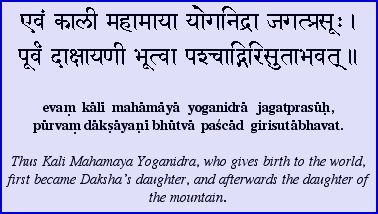well known work called the Devi Mahatmya, part of the Markandeya Purana, written around 1500 years ago.
The Devi Mahatmya also declares that the goddesses are actually forms of one great Goddess, the Mahadevi, whom it calls Yoga Nidra (mystic sleep) and Mahamaya. Maya is the principle of limitation which gives form to the world. Another name of this Mahadevi is Mahakali, that is, "Great Kali".3
When the Kalika Purana speaks of "Kali Mahamaya Yoganidra", it is referring to the same Great Goddess.
"Daksha's daughter" is Sati. "The daughter of the mountain" is Parvati. The Kalika Purana explains in
| detail how Kali has incarnated in these two forms, and has enchanted the tranquil Lord Shiva into passion and partnership.
1from Tarkaratna, Pancanana (ed); Kalikapuranam [Sanskrit in Bengali script with Bengali translation]; Navabharat Publishers, Kalikata, 1977. Chapter 44, verse 54.
2this meaning is mentioned in V.S.Apte; The Student’s Sanskrit-English Dictionary; Motilal Banarsidass, Delhi, 1970.
3the reference to Mahakali is at chapter 12 verse 38 of Jagadiswarananda (ed); Devi Mahatmyam [Sanskrit text and English translation]; Sri Ramakrishna Math, Madras, 1953.
|


